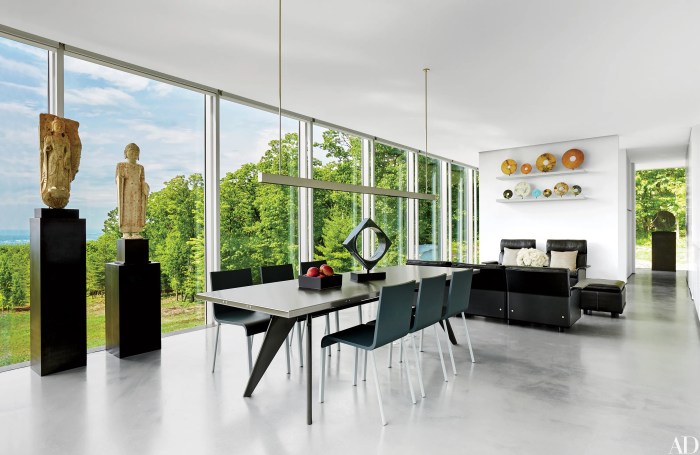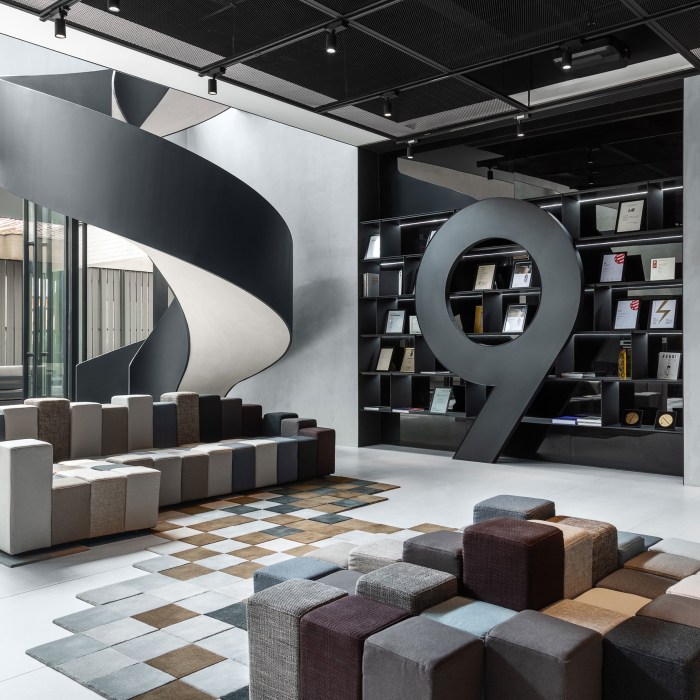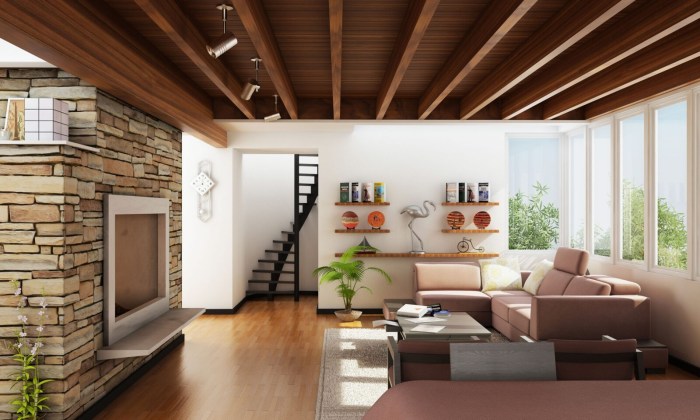Exploring the Essence of Interior Architecture

Delve into the world of interior architecture, where design meets functionality in a harmonious blend. This captivating field intertwines creativity and practicality to create spaces that inspire and awe.
From the historical evolution to sustainable design, interior architecture offers a rich tapestry of knowledge waiting to be unraveled.
Overview of Interior Architecture
Interior architecture is the design and coordination of interior spaces to create a functional, aesthetically pleasing environment. It involves the planning, organizing, and designing of interior spaces in various structures, such as residential homes, commercial buildings, or public spaces. Interior architecture plays a crucial role in shaping the way people interact with their surroundings, as it considers both the visual and functional aspects of a space.
It focuses on the structural elements of a building, such as walls, floors, and ceilings, to ensure that the space is not only visually appealing but also conducive to its intended use.
Relationship between Interior Architecture and Interior Design
Interior architecture and interior design are closely related disciplines that work together to create harmonious and functional spaces. While interior architecture deals with the structural aspects of a space, such as layout, circulation, and spatial planning, interior design focuses on the aesthetics, furnishings, and decorative elements that enhance the overall look and feel of a space.Interior architects collaborate with interior designers to ensure that the interior spaces they create are not only visually appealing but also functional and practical.
This collaboration helps in achieving a cohesive design that meets the needs and preferences of the clients while adhering to building codes and regulations.
Key Elements that Differentiate Interior Architecture
- Structural Focus: Interior architecture places a strong emphasis on the structural elements of a space, such as walls, ceilings, and floors, to create a solid foundation for the design.
- Space Planning: Interior architects carefully plan and organize interior spaces to optimize functionality and circulation, ensuring that every square foot is utilized efficiently.
- Building Codes and Regulations: Interior architects must have a thorough understanding of building codes and regulations to ensure that their designs comply with safety and accessibility standards.
- Material Selection: Interior architects select materials that not only enhance the aesthetic appeal of a space but also meet the functional requirements of the project, such as durability and maintenance.
- Integration of Technology: Interior architecture often incorporates technology into the design, such as smart home systems, lighting controls, and audiovisual equipment, to enhance the user experience and functionality of the space.
Principles of Interior Architecture

Interior architecture is guided by several fundamental principles that shape the design process and result in functional, aesthetically pleasing spaces. Spatial planning, functionality, lighting, materials, and colors all play crucial roles in interior architectural design.
Spatial Planning and Functionality
Spatial planning involves organizing and arranging the interior space to optimize functionality and flow. It considers factors such as traffic patterns, furniture placement, and the purpose of each area. Functionality focuses on creating spaces that are practical and efficient for their intended use, ensuring that the design meets the needs of the occupants.
Importance of Lighting
Lighting is a key element in interior architecture as it can significantly impact the mood, ambiance, and functionality of a space. Proper lighting design involves a combination of natural and artificial light sources to create a well-lit environment that enhances the overall design and functionality of the space.
Materials and Colors
The selection of materials and colors in interior architectural design can greatly influence the look and feel of a space. Materials such as wood, glass, metal, and textiles are chosen based on their durability, aesthetic appeal, and suitability for the intended use.
Colors play a crucial role in setting the tone and atmosphere of a space, with different hues evoking various emotions and moods.
Historical Evolution of Interior Architecture

Interior architecture has a rich history that spans across different civilizations and time periods. From ancient societies to modern times, interior architecture has evolved significantly, influenced by various architectural styles and technological advancements.
Ancient Civilizations
Interior architecture can be traced back to ancient civilizations such as Mesopotamia, Egypt, Greece, and Rome. These societies developed sophisticated architectural styles and techniques that laid the foundation for interior design principles still used today. The use of columns, arches, and decorative motifs in these ancient structures showcased the importance of aesthetics and functionality in interior spaces.
Medieval and Renaissance Period
During the Medieval and Renaissance periods, interior architecture saw a revival of classical elements from ancient civilizations. Gothic cathedrals and Renaissance palaces featured intricate detailing, ornate furnishings, and grandiose interiors that reflected the wealth and power of the ruling elite.
The emphasis on symmetry, proportion, and harmony became central to interior design during this time.
Baroque and Rococo Styles
The Baroque and Rococo styles of the 17th and 18th centuries brought a sense of drama and opulence to interior architecture. Elaborate decorations, gilded finishes, and rich fabrics characterized these periods, creating luxurious and extravagant interior spaces in palaces and churches.
These styles emphasized the use of light and color to create dynamic and visually striking environments.
Modernism and Industrial Revolution
The Industrial Revolution and the rise of Modernism in the 19th and 20th centuries marked a significant shift in interior architecture. The focus shifted towards functionality, simplicity, and efficiency in design. Technological advancements such as steel, glass, and concrete revolutionized the way interior spaces were constructed, leading to open floor plans, minimalist aesthetics, and the integration of new materials in design.
Contemporary Interior Architecture
Today, interior architecture continues to evolve with the advancements in technology, sustainability, and digital design tools. Contemporary interior designers draw inspiration from past styles while incorporating innovative solutions to create spaces that are both aesthetically pleasing and functional. The use of sustainable materials, smart technology, and virtual reality have reshaped the way interior architecture is practiced in the modern world.
Sustainable Design in Interior Architecture
When it comes to interior architecture, sustainability has become a key focus in recent years. Designing spaces that are environmentally friendly and energy-efficient is not only beneficial for the planet but also for the well-being of those who inhabit them.
Incorporating Eco-Friendly Materials
One of the ways sustainable design is implemented in interior architecture is through the use of eco-friendly materials. This includes materials that are recycled, renewable, or have a low environmental impact. For example, using reclaimed wood for flooring or furniture can help reduce the demand for new timber and minimize deforestation.
Energy-Efficient Design Principles
In addition to using eco-friendly materials, energy-efficient design principles play a crucial role in sustainable interior architecture. This can involve maximizing natural light to reduce the need for artificial lighting, incorporating efficient heating and cooling systems, and utilizing smart technologies to monitor and control energy consumption.
Examples of Innovative Solutions
There are numerous examples of innovative sustainable interior architecture solutions being implemented around the world. For instance, some projects incorporate green walls or vertical gardens to improve indoor air quality and provide insulation. Others utilize passive design strategies, such as orientation and shading, to optimize natural ventilation and reduce energy usage.
Final Wrap-Up

In conclusion, interior architecture stands as a testament to the power of design in shaping our daily environments. The fusion of history, principles, and sustainability makes it a dynamic and ever-evolving discipline worth exploring further.
General Inquiries
What sets interior architecture apart from interior design?
Interior architecture focuses more on the structural elements of a space, such as layout and flow, while interior design deals with aesthetics and decoration.
How does lighting impact interior architecture?
Lighting is crucial in setting the mood and highlighting key features of a space, playing a significant role in the overall design.
What are some examples of sustainable materials used in interior architecture?
Materials like reclaimed wood, bamboo, and recycled glass are popular choices for sustainable interior architecture projects.
How has technology influenced interior architecture practices?
Advancements in technology have allowed for more efficient design processes, better visualization tools, and innovative sustainability solutions in interior architecture.

